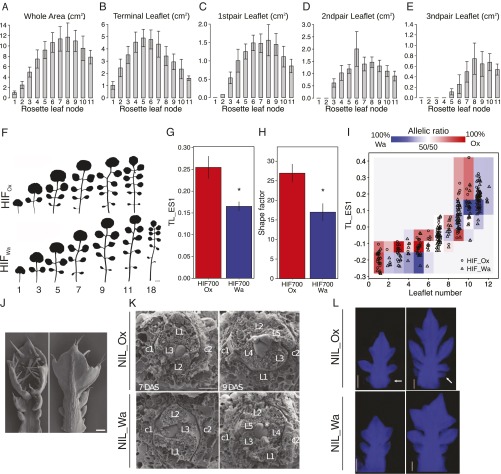Fig. S3.
Quantification of heteroblasty in C. hirsuta and the effect of ChFLC on leaf shape. Area measurements of the whole leaf (A), the terminal leaflet (B), and the first (C), second (D), and third (E) pair of leaflets. Mean values with standard deviations are shown. (F) The pace of heteroblastic progression is increased in early flowering lines carrying the ChFLCOx allele. Heteroblastic series of HIF700_Ox (Top) and HIF700_Wa (Bottom). Rosette leaf number is indicated below leaves. (G) Terminal leaflet shape of the last rosette leaf to develop before flowering differs significantly between HIFs bearing either the Ox or the Wa ChFLC allele. Bar chart shows the mean values for TL_ES1, which is the eigenshape explaining most of the variation in shape of the terminal leaflet. Error bars indicate standard errors of the means; asterisk indicates that the difference is significant (P < 0.05 by Student's t test). (H) The last rosette leaves to develop before flowering on HIFs bearing the Ox allele have a higher shape factor [leaf perimeter2 / (leaf area * 4π)] than those bearing the Wa allele. Bar chart shows mean differences in shape factor; error bars show standard errors of the means; asterisk indicates that the difference is significant (P < 0.05 by Student's t test). (I) Relative abundance of leaves from HIFs 700 and 732 in the shape space of leaflet number and terminal leaflet shape. All samples were divided into 6 bins of TL_ES1 for each possible number of leaflets such that each bin contained as close as possible to an equal number of leaves. Colored bins indicate a higher relative ratio of leaves from Ox (red) and Wa (blue). The intensity of the color indicates how strong the respective allele dominated the ratio over the other allele. For example, leaves with 5 leaflets from plants with the Wa allele tended to have a more juvenile shape than those of plants with the Ox allele, which is shown by the dark blue color in the bin for low TL_ES1, while the bins above it are red. Actual values of TL_ES1 are plotted against leaflet number for plants with the Ox allele (circles) and the Wa allele (triangles); some jitter was applied to separate the data points in the figure. The HIFs 700 and 732 were not found to differ from each other for these traits so they were analyzed together [P < 0.05 by Student's t test (TL_ES1) or Kruskal–Wallis test (leaflet number)]. (J) Scanning electron micrographs (SEM) show rosette leaf 5 lacking abaxial trichomes. (Scale bar: 100 μm.) (K) SEM of vegetative apices of NIL_Ox and NIL_Wa at 7 and 9 DAS revealed the initiation of leaf 3 and 5, respectively. Stipules are indicated with a *. Cotyledons are indicated with the letter C. Rosette leaves are indicated with the letter L. (Scale bar: 100 μm.) (L) Confocal laser scanning micrographs of rosette leaf 9 show that more leaflets are initiated per unit leaf length in the early flowering NIL_Ox compared to NIL_Wa. White arrows point to developing leaflets in NIL_Ox. (Scale bar: 100 μm.)

